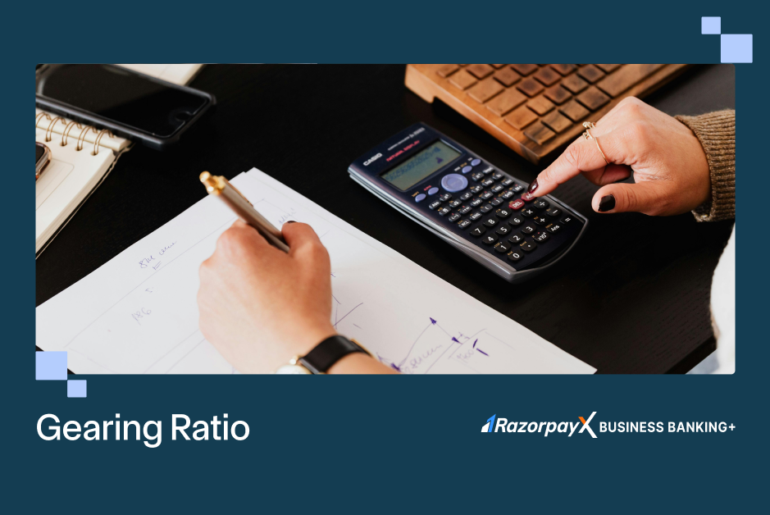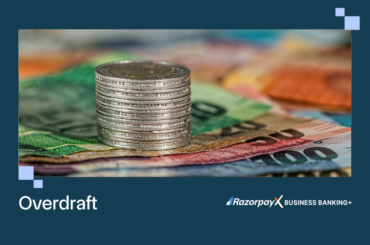Table of Contents
Introduction
In 2023, the bad debt-to-sales ratio ranged between 0.07% and 1.37%, showing just how much debt can impact the stability of companies.
This is where understating gearing ratio’s meaning becomes important. It’s a simple yet powerful metric that compares how much of a company is funded by debt versus equity. It’s not just about numbers; it’s about understanding how stable and secure a business really is!
This article breaks down the what gearing ratio is, it’s formula, and shows how to interpret it. Just knowing how to calculate and evaluate a good gearing ratio can provide a clearer picture of a company’s financial footing.
What Is the Gearing Ratio and Why Is It Important?
The gearing ratio is a key financial metric that evaluates how much of a company’s operations are financed through debt compared to equity. It helps determine a company’s financial leverage, i.e. how much the business relies on borrowed funds versus shareholder investment.
A gearing ratio calculation compares a company’s debt, such as loans and borrowings, to its equity capital. This helps investors understand the company’s ability to manage and repay its obligations.
Higher gearing ratios indicate more debt relative to equity, which could signal higher financial risk, while lower ratios suggest a healthier balance between debt and equity.
The evolution of gearing ratios over time is a clear indicator of the changing nature of financial management and business operations. Today, these ratios are essential for investors and corporate managers alike, helping them guide decisions on funding strategies and risk management.
Whether it is being used to analyze the company’s capital structure or assess its working capital, understanding gearing ratio offers significant data about a company’s stability and financial health.
How to Calculate the Gearing Ratio: Formula
The gearing ratio formula is a simple yet effective way to measure a company’s financial leverage. To calculate it, divide the company’s total debt by its shareholders’ equity, then multiply by 100 to get a percentage.
The standard formula for the gearing ratio is:
Gearing Ratio = (Total Debt / Shareholders’ Equity) × 100
Here’s a practical example:
Suppose a company, Deneze Ltd., has ₹7,00,000 in total debt and ₹12,00,000 in shareholders’ equity. The gearing ratio would be:
Gearing Ratio = (₹700,000 / ₹1,400,000) × 100 = 50%
This means that 50% of Deneze Ltd.’s capital structure is financed through debt, suggesting a balanced approach.
For businesses looking to simplify their financial calculations can benefit from real-time information offered by tools like RazorpayX’s Business Banking+.
Such tools help businesses track and manage financial metrics like cashflow, and costs efficiently with their business account and tracking feature. With Razorpay’s banking solutions, businesses can easily understand their finances and have accurate, up-to-date financial data at their fingertips.
Explore RazorpayX Business Banking+
How To Interpret Gearing Ratio of a Company
A gearing ratio provides information about a company’s financial structure by showing how much of its operations are funded by debt and how much by equity capital. The interpretation of the gearing ratio depends on three level– low, moderate, or high.
Low Gearing Ratio (Below 25%)
A gearing ratio below 25% shows the company’s minimal dependence on debt, suggesting a conservative financial approach. Although this usually indicates a lower level of financial risk, it can also limit potential for growth as the business may lose out on funding for growth projects during periods of low interest rates.
Industries with stable operations and low capital intensity, such as service-based businesses, often have low gearing ratios.
Moderate Gearing Ratio (Between 25% and 50%)
This gearing ratio is generally seen as a balanced approach. It is usually suitable for many well-established companies. It displays an ideal balance between debt and equity, providing flexibility while preserving regulated financial risks.
High Gearing Ratio (Above 50%)
A high ratio, above 50% indicates that a company heavily relies on debt financing. While this might benefit them from tax advantages of debt, but the risks associated are also greater. This is true usually during economic downturns or when interest rates rise.
Companies with high gearing ratios may face higher interest expenses and reduced financial flexibility, increasing the likelihood of default or bankruptcy if their revenue doesn’t keep up with debt obligations.
What Are the Risks Associated with Gearing Ratios?
A high gearing ratio exposes companies to several financial risks. One key risk occurs during economic downturns. Companies with high gearing are more vulnerable to cash flow shortages, making it harder for them to meet debt obligations.
Another major risk occurs when the interest rates rise. Having a higher gearing ratio usually increases the company’s exposure to rising interest rates, which can inturn erode their cashflow.
One more concern is limited financial flexibility, as highly geared companies can struggle to get additional capital or adjust strategies quickly without increasing their debt.
On the other hand, it’s important to remember that having a low gearing ratio doesn’t always guarantee a healthy capital structure.
Some industries, such as capital-intensive or cyclical sectors, often require debt to finance operations, making low gearing impractical.
Improper gearing levels, either too high or too low, can lead to financial challenges. Companies must weigh these risks down carefully to maintain a gearing ratio that suits their industry and growth strategy.
Can Gearing Ratios Be Improved?
Yes, companies can take several steps to reduce high gearing ratios and improve their financial stability.
One common approach is reducing debt by using profits or refinancing loans to lower the overall debt burden.
Another method involves raising equity by issuing new shares or by retaining earnings instead of paying out dividends, which thus increases the equity portion of the company’s capital structure.
Companies can even work on improving their operational efficiency and boosting profits through better cost management to generate extra funds to pay off debt.
Additionally, selling non-essential assets can also provides immediate cash that can be used to reduce debt.
For businesses regular monitoring of the gearing ratio is essential to ensure long-term financial growth. They need to adjust their strategies as conditions change and their business grows.
With RazorpayX’s Business Banking+ you get quick and compliant financing options which help with streamlining expense management, supporting businesses in reducing debt and maintaining balanced financials.
Explore RazorpayX Business Banking+
Conclusion
The gearing ratio is a significant financial indicator that shows how well a company’s debt and equity are balanced. It helps companies and investors measure their long-term economic potential by acting as a crucial indication of financial risk.
From understanding its meaning to calculating and interpreting it’s different levels, the gearing ratio provides information of the company’s financial structure.
A high ratios signifies greater risk but potential for growth, while low ratios indicate stability with limited expansion opportunities. It’s important to regularly monitor debt management, and operational efficiency to maintain a healthy gearing ratio.
A balanced gearing ratio is the foundation for sound financial health.
FAQs
What is a good gearing ratio?
A good gearing ratio ranges between 25% and 50%, reflecting a balance between debt and equity. However, the ideal ratio varies by industry and company, depending on capital needs and risk tolerance.
How can you reduce gearing ratio?
A company can reduce its gearing ratio by paying off debt, increasing profits, cutting operational costs, and improving inventory management. These measures decrease liabilities and strengthen the equity portion of the financial structure.
What are the key limitations of gearing ratios?
The gearing ratio doesn’t account for industry-specific differences, external factors like recessions, or intangible elements like workforce efficiency. Companies without debt can also appear financially healthy despite other challenges.
Why do gearing ratios vary by industry?
Industries with high capital needs, like utilities or telecom, naturally have higher gearing ratios due to reliance on debt for large investments. Conversely, sectors with stable cash flows often operate with lower gearing ratios.
How does working capital relate to gearing ratios?
Working capital measures short-term financial health, while the gearing ratio shows long-term debt reliance. A strong working capital position supports debt management, while high gearing ratios can strain working capital reserves.





